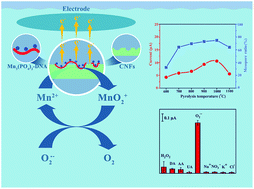Tailoring pore structures with optimal mesopores to remarkably promote DNA adsorption guiding the growth of active Mn3(PO4)2 toward sensitive superoxide biomimetic enzyme sensors
Abstract
The great challenge in preparing a biomimetic enzyme sensor is to have sensitivity and selectivity equal to or better than its corresponding biological sensor. Porous electrodes possess a large surface area and are often used to greatly improve the sensor sensitivity. However, how to tailor the pore structure, especially the pore size distribution to further improve the sensitivity and selectivity of a biomimetic sensor, has not been investigated yet. The superoxide anion (O2˙−) plays essential roles in various biological processes and is of importance in clinical diagnosis and life science research. It is generally detected by the superoxide dismutase enzyme. Herein, we delicately tailor the pore structure of carbon nanofibers (CNFs) by pyrolysis to obtain an optimal mesopore structure for strong adsorption of DNA, followed by guiding the growth of Mn3(PO4)2 as a biomimetic enzyme toward highly sensitive detection of O2˙−. The Mn3(PO4)2–DNA/CNF sensor achieves the best sensitivity among the reported O2˙− sensors while possessing good selectivity. The enhancement mechanism is also investigated, indicating that the mesopore ratio of CNFs plays an essential role in the high sensitivity and selectivity due to their strong adsorption of DNA for guiding the growth of a large amount of uniform sensing components, Mn3(PO4)2, toward high sensitivity and selectivity. The biomimetic sensor was further used to in situ monitor O2˙− released from human keratinocyte cells and human malignant melanoma cells under drug stimulation, showing high sensitivity to real-time quantitative detection of O2˙−. This work provides a highly sensitive in situ real-time biomimetic O2˙− sensor for applications in biological research and diagnosis, while shedding light on the enhancement mechanism of the pore structure, especially the pore size distribution of a porous electrode for high performance sensing processes.



 Please wait while we load your content...
Please wait while we load your content...